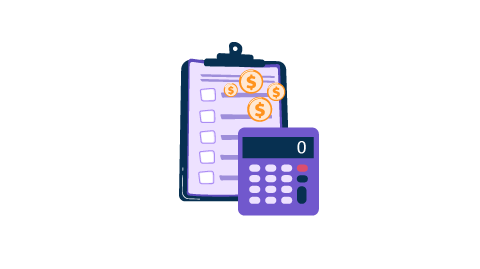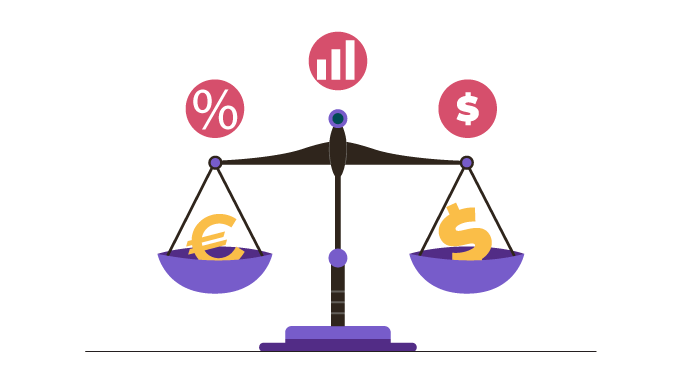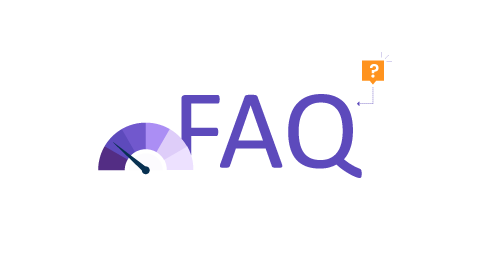All You Need to Know About Profit-Sharing
Do you have a thriving business? Are you looking for a different way to compensate your employees? If that's the case, a profit-sharing plan is just right for you! It is an excellent option if you want to encourage a culture of collaboration and a win-win situation for both.
According to a Gallup poll, 40% of the employees want profit-sharing options as a part of their compensation plan. So this is a good enough reason why you need to consider thinking about it.
So before you start planning, here is all you need to know about profit-sharing.
What is Profit-Sharing? How Does it Work?

In simple words, profit-sharing is a way to contribute a portion of your company's profit to your employees. An employer can choose to pay it directly or indirectly along with their salary and bonuses. It depends on the employee's salary package and also the overall revenue generated by the company. The company can choose how much or how little it will contribute to an employee's plan from year to year.
Profit-sharing requirements and methods vary from one country to another.
For example, suppose an employer pays a fixed percentage of profits to the employee. In that case, only a certain percentage is taxed for that amount. But, in Canada, the employee's share of profits is tax-free, up to 15 percent of their total employment income.
In countries such as the UK, the US, and Canada, large businesses usually offer profit-sharing plans. Even businesses with fewer than five employees can provide profit-sharing programs. But, the options may be limited in comparison to larger companies.
Types of Profit-Sharing Plan

Profit-sharing plans are primarily divided into three categories.
1. Current Profit-Sharing Plan
In this type of profit-sharing plan, the employer chooses to pay the remuneration when allocating the profit. It can be in the form of cash or stocks. It usually happens annually or as the case may be.
One of its benefits is that it provides employees with instant gratification for their contributions to the company. In addition, it gives them a recency effect that leads to employee motivation. However, the downside of this type of profit-sharing is that the total amount is taxable as a regular income.
2. Deferred Profit-sharing Plan
In a deferred profit-sharing plan, the time of withdrawal is set later or at the time of retirement, death, or termination of employment. In addition, the employer sets a lock-in period before which the employee cannot withdraw the money.
In such plans, the employer combines the profit-sharing with the 401(k) plan. By doing so, the amount becomes non-taxable at the end of the term. Thus, implementing such a plan results in enhanced employee retention.
3. Hybrid Profit-sharing Plan
As the name suggests, it is a combination of both the above two types of plans, giving employees the best of both worlds. A portion of the profit is earmarked for their retirement plan, and the rest is encashed. It helps them save up on some taxes and also makes them feel instant gratification towards the company.
Apart from these three types of profit-sharing plans, let's look at two of the most common terms that people confuse with a profit-sharing method.
Profit-sharing Vs. 401(k)
401(k) is the name of a section in the Internal Revenue Code (IRS). A certain amount of money is allocated to an employee's account every year.
It is a non-taxable retirement plan sponsored by employers. Profit-sharing is often included in an employee's retirement plan by their employer.
So, these two might seem confusing to many. Here are some points that will help you differentiate between the two.
| Profit-sharing | 401(k) |
|---|---|
| Employer contributes the amount solely. | Both employer and employee contribute a certain amount. |
| The amount contributed is discretionary and based on company profits. | The employer can match the contribution of the employees. |
| It can fluctuate from time to time as it based on company profits. | There is a fixed percentage of the amount that the employer contributes. |
Profit-sharing Vs. Bonus
Both types of compensation are based on the company's profits. But, this doesn't make both of them similar. So, let's look at some of the differences below.
| Profit-sharing | Bonus |
|---|---|
| Profit-sharing can be a part of the employee's retirement plan. | Bonuses are a part of the employee's annual compensation. |
| Employees receive the amount at the time of retirement if it is merged with their 401(k) plan. It imposes a percentage of penalty fees in the event of an early withdrawal. | Bonuses are given annually. Mainly at the time of Christmas. There is no option to withdraw. |
| Employees are compensated in the form of cash, stocks, or bonds. | Bonuses are in the form of cash payments. |
What are the Approaches to Profit-Sharing?
Companies have different approaches to profit-sharing. It varies on the size of the company and the nature of the business. Most of the companies offering a profit-sharing scheme follow one of the following approaches.
1. Pro-rata Approach
A pro-rata plan is where every employee, irrespective of hierarchy, gets an equal share. It is either in the form of cash or stocks. Every employee is allocated the same percentage of the profits. This simplifies the whole process of profit-sharing but might not be applicable for all cases. It is best suited for small businesses or a new profitable business.
2. Balanced Approach
A profit-sharing option does not have to be a company-wide offering. It works best for a large employee base with varying employee responsibilities.
Employees are divided into distinct benefit groups for calculating their profit share. Eligible employees receive the percentage of profits at different rates based on their position and contribution.
The profit allotment can be tricky in this approach. Still, it gives much flexibility to the employers in deciding who gets what.
3. Age-Weighted Approach
This profit-sharing scheme equals the contribution to their retirement savings. The profit share is calculated based on their tenure of employment to the company. The longer the term, the greater the percentage. It is an excellent way of improving employee retention and attracting new talents as well.
Benefits of Profit-sharing

It's no surprise how an organization can benefit from it in many ways. Here are some of the significant benefits that you can gain.
1. Attract and Retain Talent
One of the core benefits of a profit-sharing plan is employee retention. From the employee's point of view, knowing that their hard work directly impacts the company's revenue is a great motivation to work harder. Also, it is always a great privilege for employees when a company contributes to their retirement account.
For example, subject the profit-sharing payments to a five-year vesting period. To keep all the money, employees who get these funds must work for your organization for five years.
If they depart after two years, employees are paid only partially for their contributions. It provides additional motivation for your staff to stay with you.
2. Tax Benefit
It is a win-win for both employees and employers. A profit-sharing plan with 401(k) is tax-deductible, which is a great benefit, especially for local businesses. It is also an easy way to save for retirement for the employees.
It's also worth mentioning that as long as both parties contribute a total of $51,000 ($56,500 for employees over 50) to the 401(k) profit-sharing plan, those expenditures are tax-deductible.
3. Loyalty
Sharing the earnings with your employees develops a sense of ownership towards the company and increases employee loyalty.
It encourages them to perform better and stay invested in the company's success. They are incentivized to work harder and produce better results. Simply put, better results equate better bank accounts.
4. Employee Motivation
It is an excellent way to keep up employee motivation and employee engagement. Employees get to see the bigger picture, which makes them feel responsible for their jobs. They can see the direct impact of their efforts. They remain invested in the company's earnings because of the potential financial rewards associated with it.
According to an HBR case study, serving the company's long-term vision fostered a sense of intrinsic motivation and pride.
Recommended Read: Employee Benefits & Compensation Ideas for Your Workforce
Common FAQs

1. Is profit-sharing good for employees?
Answer: Yes, it can be a great way to boost employee morale and loyalty towards your company. Being a part of the company's profits makes them vested in improving the company's performance.
2. What are the disadvantages of profit-sharing?
Answer: One of the disadvantages is that it can cause discontentment among some workers. It seems to be unfair when somebody gets a higher share when everyone puts in the same effort. Similarly, suppose everybody gets an equal share. In that case, it can be unfair to those who do the bare minimum and get equally paid.
3. How do you calculate the profit-sharing ratio?
Answer:
- Take each employee's compensation and divide it by the total payment.
- Multiply the total profits of that year by the profit percentage.
- Multiply the two results to get each employee's profit share.
4. What is profit-sharing example?
Answer: Say you have a total number of 5 employees. Each employee gets $20,000 per month. So, total compensation amounts to $1,00,000.
Suppose you made a profit of $1,00,000 that year and decide on 20% of profit for each employee.
Therefore, each employee's profit will be -
($20,000 / $2,00,000) X (20% X $1,00,000) = ($0.1) X ($20,000) = $2000
5. Is profit-sharing considered a bonus?
Answer: Some give out the profit share amount as cash periodically. In that case, it is considered a bonus and taxed as a regular income.
6. Is profit-sharing taxable?
Answer: In cases where the profit share is combined with a 401(k) plan, the amount becomes non-taxable. If it is given out as cash, it becomes taxable just as a regular income.
7. Do terminated employees get profit-sharing?
Answer: If the employees get involuntarily terminated, you can pay the employee a lump sum amount when they worked during the year. This is often considered severance pay. Suppose the employee's profit-sharing plan was part of the 401(k) plan. In that case, their contributions carry forward to their next employment.
8. What are the features of profit-sharing?
Answer: The features are as follows:
- The company must be profitable.
- In case of losses, employees do not share the losses.
- It can be distributed as cash, stocks, or as a part of the retirement plan.
- It is paid out of net profits and not gross profits.
9. Why is profit-sharing important?
Answer: It is one of the most effective strategies to compensate employees for their contributions fairly. If planned carefully, it is an excellent source of employee motivation and dedication.
10. Who started the profit-sharing plan first?
Answer: It developed in the first half of the 19th century in France. It was introduced to promote harmony between workers and employers and raise productivity. Later it was adopted in many other countries like the Latin American countries and Europe.
11. Can a company have a 401(k) and profit-sharing plan?
Answer: Yes, a company can merge both of the plans as a retirement plan. They can also decide to keep them separate as individual plans.
12. What is the maximum 401k profit-sharing contribution for 2022?
Answer: On October 26, 2020, the IRS released retirement plan limits for 2021. The annual contribution limit for 2021 is $58,000. It is expected to be the same for 2022.
13. Which is better, equity or profit-sharing?
Answer: Equity is better for new businesses that need immediate capital to make it running. Profit-sharing is best for established businesses that need to attract and retain talent.
14. What are the objectives of profit-sharing?
Answer: The objectives of profit-sharing are:
- To increase productivity.
- To encourage a sense of belonging and responsibility.
- To provide tax benefits for both employees and employers.
- To increase employee retention.
Summary
To implement a profit-sharing plan, you must be upfront about company finances. You don't have to tell the turnover or the gross profit. But you have to be transparent about some of the bottom-line numbers.
It is also essential for your company to be making stable profits. Sometimes people are offered a large profit share that heightens their expectations.
Sometimes the profit share is too less that it doesn't excite them at all. So, it would be best if you found a nice balance to keep them motivated.

















